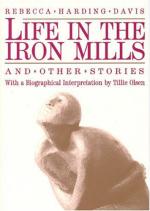|
This section contains 6,781 words (approx. 23 pages at 300 words per page) |

|
SOURCE: “‘Life in the Iron Mills': A Nineteenth-Century Conversion Narrative,” in The American Transcendental Quarterly, Vol. 5, No. 4, December, 1991, pp. 245-57.
In the following essay, Shurr contends that the narrator of “Life in the Iron Mills” is the character Mitchell, and that the story can be best understood as a conversion narrative.
“Life in the Iron Mills” by Rebecca Harding Davis now occupies a secure place in the canon of American literature. Walter Hesford has shown that the story has deep roots in earlier American literary traditions; looking in the other direction, Jean Pfaelzer has declared that the story “must be considered as a central text in the origins of American realism, American proletarian literature, and American feminism” (239). Judith Fetterley has explicated the powerful central figure of the korl woman: here, for the first time, “is a woman's body imagined as an expression of power and longing in a...
|
This section contains 6,781 words (approx. 23 pages at 300 words per page) |

|


